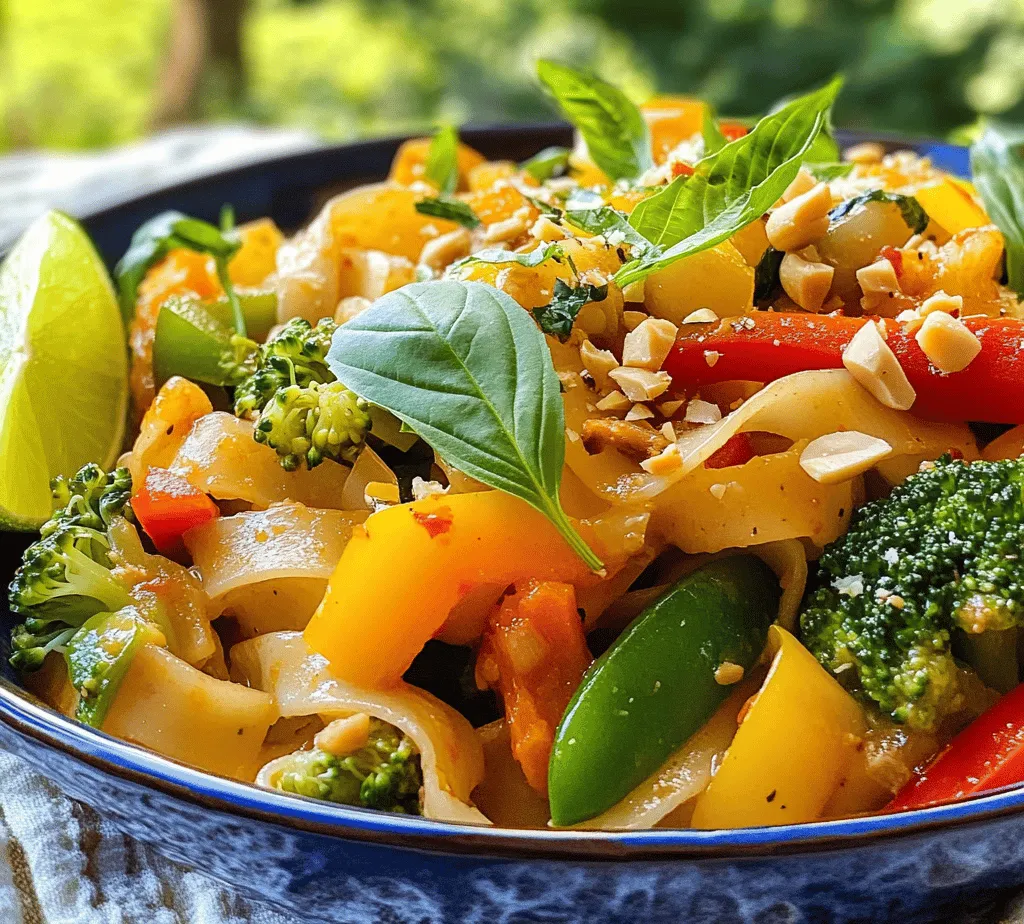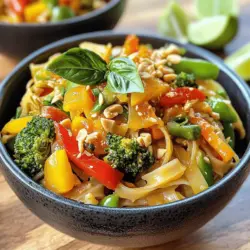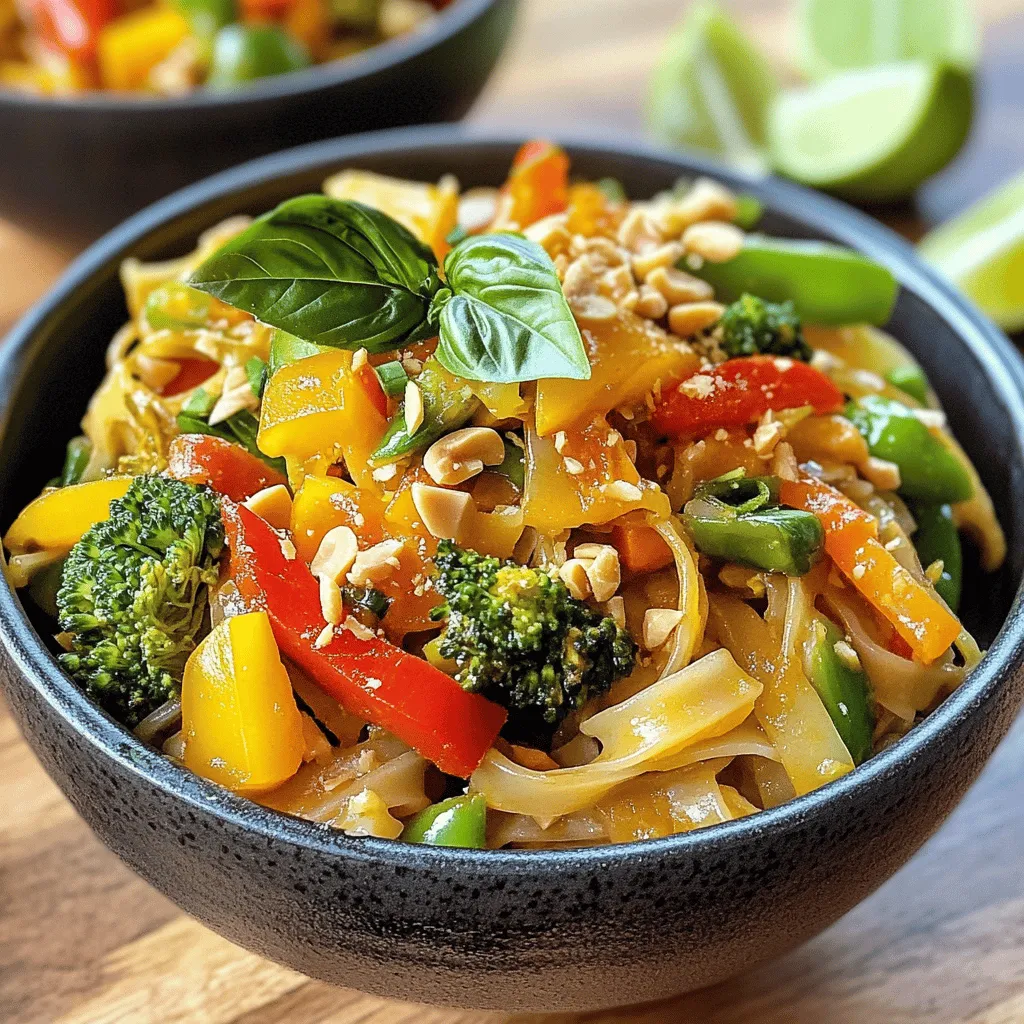Introduction
Thai cuisine is renowned for its vibrant flavors, bold spices, and aromatic ingredients that tantalize the taste buds and soothe the soul. With a perfect balance of sweet, sour, salty, and spicy, every dish tells a story of its cultural heritage and culinary artistry. Among the myriad of delightful Thai dishes, Spicy Thai Drunken Noodles, or “Pad Kee Mao,” stands out as a fan favorite, celebrated for its unique combination of flavors and textures.
Known for its rich umami taste and delectable heat, Spicy Thai Drunken Noodles have gained immense popularity both in Thailand and worldwide. This dish has a reputation for being a late-night indulgence, offering a satisfying meal that can easily be made at home with the right ingredients and techniques. The secret to achieving the authentic flavors of this dish lies in the freshness of the ingredients used, making it a delightful option for anyone looking to explore the essence of Thai cooking.
Understanding Drunken Noodles
The origins of Drunken Noodles are as intriguing as its name suggests. Traditionally, it is said that the dish was created for drunken revelers, serving as a hearty remedy to combat the effects of a night of indulgence. However, the exact backstory varies, adding to the charm of this beloved dish. Often, it is prepared with wide rice noodles, vegetables, and a variety of spices, making it versatile and adaptable to personal preferences.
Drunken Noodles hold a special place in Thai cuisine, often compared to other popular noodle dishes like Pad Thai and Pad See Ew. While Pad Thai is characterized by its sweet and tangy sauce with a hint of tamarind, and Pad See Ew features a savory soy sauce blend, Drunken Noodles stand out with their bold, spicy flavors and a more robust garlic and chili profile. The generous use of fresh vegetables in Drunken Noodles not only enhances its taste but also provides a delightful crunch that contrasts beautifully with the chewy noodles.
The role of spice and heat in Thai cooking cannot be overstated. Thai cuisine embraces a variety of chili peppers, which infuse dishes with not just heat but also depth. The heat from the chilis in Spicy Thai Drunken Noodles is balanced by the sweetness of sauces, creating a harmonious blend that excites the palate. This balance is essential, as it reflects the core philosophy of Thai cooking: to achieve an equilibrium of flavors.
Ingredients Breakdown
Creating the perfect plate of Spicy Thai Drunken Noodles starts with understanding the key ingredients that contribute to its distinctive flavor profile.
Wide Rice Noodles
At the heart of Drunken Noodles is the wide rice noodle, known as “sen yai.” These flat noodles possess a chewy texture that beautifully absorbs the sauce, enhancing the overall taste experience. When cooked properly, they provide a satisfying bite that complements the dish’s other components. To achieve the ideal texture, it’s essential to soak the noodles beforehand and cook them al dente, allowing them to soak up the sauce without becoming mushy.
Fresh Vegetables
Fresh vegetables are not only vital for flavor but also bring a wealth of nutritional benefits to the dish. Common vegetables used in Drunken Noodles include bell peppers, carrots, and broccoli. These veggies add a crisp texture and a burst of color, making the dish visually appealing. Moreover, they contribute essential vitamins and minerals, making this dish a wholesome choice for any meal.
Aromatics: Garlic, Ginger, and Chili
Aromatics play a crucial role in elevating the flavors of any dish, and Spicy Thai Drunken Noodles are no exception. Garlic, ginger, and chili are the holy trinity of Thai cooking, providing layers of flavor and aroma. Garlic adds a savory depth, while ginger contributes a peppery warmth. The chilis introduce the signature heat that Drunken Noodles are known for. The choice of chilis can be adjusted based on personal spice tolerance, allowing for a customized experience.
Sauces: Balancing Sweet, Salty, and Sour
The sauces used in Drunken Noodles are essential for achieving the right balance of flavors. The primary sauces include soy sauce, oyster sauce, and sometimes fish sauce. These ingredients provide the salty component, while sugar or palm sugar adds sweetness, and lime juice introduces a tangy note. Properly balancing these flavors is key to creating a sauce that complements the noodles and vegetables, resulting in an unforgettable dish.
Thai Basil
No Thai dish is complete without the fragrant addition of Thai basil. This herb has a unique flavor profile that combines notes of anise and pepper, creating a distinct aroma that enhances the overall dish. Thai basil is typically added at the end of cooking, allowing its flavor to infuse the noodles without losing its freshness. If you can’t find Thai basil, you may substitute it with regular basil, but the taste will differ slightly.
Ingredient Substitutions
For those with dietary restrictions or preferences, there are several ingredient substitutions that can be made without sacrificing flavor. For a vegetarian or vegan version, tofu or tempeh can replace any meat options. Gluten-free soy sauce can be used for those avoiding gluten, and vegetable broth can substitute for fish sauce to maintain the umami flavor. Additionally, a variety of vegetables can be swapped in or out based on seasonal availability or personal taste.
Preparation Steps
Now that we have a thorough understanding of the ingredients, let’s dive into the preparation of Spicy Thai Drunken Noodles. Follow these detailed steps to create a dish that’s sure to impress.
Step 1: Soaking and Cooking the Noodles
Begin by soaking the wide rice noodles in warm water for about 30 minutes or until they are soft but still firm to the bite. Drain the noodles and set them aside. When you are ready to cook, bring a pot of water to a boil. Add the soaked noodles and cook them for 2-3 minutes until they are just tender. Be careful not to overcook them, as they will continue to cook in the stir-fry. Drain the noodles again and rinse them under cold water to stop the cooking process. This step ensures that the noodles maintain their perfect texture in the final dish.
Step 2: Preparing the Sauce
While the noodles are soaking, it’s time to prepare the sauce. In a small bowl, combine the soy sauce, oyster sauce, fish sauce (if using), sugar, and lime juice. Whisk them together until the sugar dissolves completely. Taste the sauce and adjust the balance according to your preference, adding more lime for tanginess or sugar for sweetness. A well-balanced sauce is crucial for the dish, as it will tie all the flavors together beautifully.
Step 3: Stir-Frying the Ingredients
In a large wok or skillet, heat a tablespoon of vegetable oil over medium-high heat. Add the minced garlic and ginger, stirring quickly to release their aromas. Next, toss in the sliced vegetables and stir-fry for about 3-4 minutes until they are tender yet crisp. If you are adding protein, such as chicken or shrimp, incorporate it at this stage and cook until fully done.
Once the vegetables and protein are cooked, add the soaked and drained noodles to the wok. Pour the prepared sauce over the noodles and gently toss everything together, ensuring the noodles and vegetables are well coated. Stir in the Thai basil, allowing it to wilt slightly before serving. The final step is to add freshly sliced chilis for an extra kick, adjusting the amount based on your spice preference.
By following these steps, you’ll be well on your way to creating a sensational plate of Spicy Thai Drunken Noodles that will transport you to the bustling streets of Thailand with every bite. Stay tuned for more tips and tricks to achieve the best results, ensuring your homemade noodles are as authentic and delicious as those found in your favorite Thai restaurant.

Stir-Frying Technique: Maintaining the Crunch of Vegetables
One of the quintessential aspects of preparing Spicy Thai Drunken Noodles is the stir-frying technique, which plays a crucial role in preserving the crunchiness of the vegetables while ensuring they are cooked to perfection. The key lies in high heat and quick cooking.
1. Wok Temperature: Before adding any ingredients, preheat your wok or skillet over medium-high heat until it’s hot. A well-heated pan allows for instant searing, ensuring that the vegetables cook quickly while retaining their natural texture.
2. Sequential Cooking: Start with the proteins (if using meat or tofu) and let them brown slightly before adding the vegetables. This not only adds flavor but also prevents overcooking the delicate vegetables.
3. Batch Cooking: If you’re preparing a large batch, consider cooking in smaller portions. This prevents overcrowding the pan, which can cause steaming rather than stir-frying.
4. Adding Vegetables: Incorporate vegetables that cook at different rates. For example, add bell peppers and carrots first, as they take longer to soften, followed by softer veggies like bok choy or bean sprouts, which need only a quick toss.
5. Toss, Don’t Stir: Use a spatula to toss the ingredients rather than stirring them continuously. This technique allows for even cooking while preventing the vegetables from getting mushy.
Importance of Timing and Temperature in Cooking
Timing and temperature are crucial in achieving the perfect Spicy Thai Drunken Noodles. Cooking on high heat is essential for creating a stir-fry that is both flavorful and textured.
– Quick Cooking: The entire process should take no longer than 10-15 minutes. This speed ensures that the ingredients maintain their fresh taste and vibrant colors.
– Ingredient Order: Pay close attention to the order of ingredients. Proteins, followed by harder vegetables, and finally softer ones should be introduced sequentially, allowing each to cook just enough without losing their essential properties.
– Final Toss: Once everything is in the wok, a final toss with the sauce brings all elements together, allowing the noodles to absorb the flavors while keeping the vegetables crisp.
Visual Aids: Suggested Images for Each Step
To enhance the cooking experience and ensure clarity, consider including visual aids for each major step of the cooking process. Images can be particularly helpful for:
– The vibrant selection of ingredients before preparation.
– The progression of cooking—showing the proteins browning, then adding vegetables at different stages.
– The final presentation of the dish, highlighting the colorful components and garnishes.
– Each step should have a clear image that depicts the expected outcome, aiding in visual learning and instilling confidence in the cook.
Flavor Profiles and Spiciness Levels
Spicy Thai Drunken Noodles are beloved not only for their delightful taste but also for their complex flavor profiles. Understanding these components will elevate your dish and allow you to customize it to your preference.
1. Flavor Components: The dish is characterized by a balance of sweetness, saltiness, and acidity. The sweetness primarily comes from sugar or palm sugar, while the saltiness derives from soy sauce or fish sauce. A squeeze of lime adds a refreshing acidity that cuts through the richness of the noodles.
2. Adjusting Spiciness: The level of spiciness is adjustable based on individual taste. For a mild version, reduce the amount of chili paste or fresh chilies used. Alternatively, you can substitute with a milder sauce or omit the spicy elements altogether.
3. For Sensitive Palates: If you are catering to someone with a lower tolerance for spice, consider using sweet chili sauce or adding a dash of coconut milk to mellow the heat without compromising flavor.
Serving Suggestions
Spicy Thai Drunken Noodles can be a stunning centerpiece for any meal, and pairing it correctly can enhance the overall dining experience.
1. Accompaniments: Serve your noodles with fresh Thai basil or cilantro on top for an aromatic finish. Additionally, side dishes like spring rolls or a light cucumber salad can complement the meal beautifully.
2. Beverage Pairings: For a drink that balances the spiciness of the dish, consider serving iced Thai tea or a light lager beer. The creaminess of the tea and the crispness of the beer can both soothe the palate.
3. Presentation Tips: To make your dish visually appealing, plate the noodles in a nest formation and scatter the vegetables and protein artfully on top. A sprinkle of crushed peanuts or sesame seeds can add texture and a pop of color.
4. Traditional Serving Styles: In Thai culture, meals are often shared, so consider serving the Spicy Thai Drunken Noodles family-style in a large dish, allowing everyone to help themselves and enjoy the communal experience of dining.
Nutritional Information
Understanding the nutritional content of your meal can help you make informed decisions about your diet. Here’s a breakdown per serving of Spicy Thai Drunken Noodles:
– Calories: Approximately 350-400 calories
– Proteins: 15-20 grams (depending on the protein source)
– Fats: 10-15 grams (mostly from oil and proteins)
– Carbohydrates: 50-60 grams (from the noodles)
– Vitamins and Minerals: Rich in vitamin A (from bell peppers and carrots), vitamin C (from lime and vegetables), and various antioxidants.
Health Benefits of Ingredients
The ingredients in Spicy Thai Drunken Noodles offer numerous health benefits:
– Vegetables: Packed with vitamins, minerals, and fiber, they contribute to overall health and well-being.
– Herbs: Fresh herbs like basil and cilantro are known for their anti-inflammatory properties and contribute to digestive health.
– Whole Grains: If you choose whole grain or rice noodles, you’ll benefit from additional fiber and nutrients.
Conclusion
Spicy Thai Drunken Noodles are a delightful dish that showcases the vibrant flavors of Thai cuisine. With their perfect balance of spice, sweetness, and acidity, these noodles present a unique culinary experience that is both satisfying and exciting.
Whether you’re a seasoned cook or a novice in the kitchen, making this dish at home is an excellent way to explore new flavors and hone your cooking skills. Embrace the joy of cooking by trying your hand at this delicious recipe, and don’t hesitate to experiment with the ingredients to find the perfect balance for your palate.
Enjoy the adventure of cooking and the pleasures of sharing your creations with family and friends. Dive into the world of Thai cuisine and let the Spicy Thai Drunken Noodles inspire your culinary journey!



